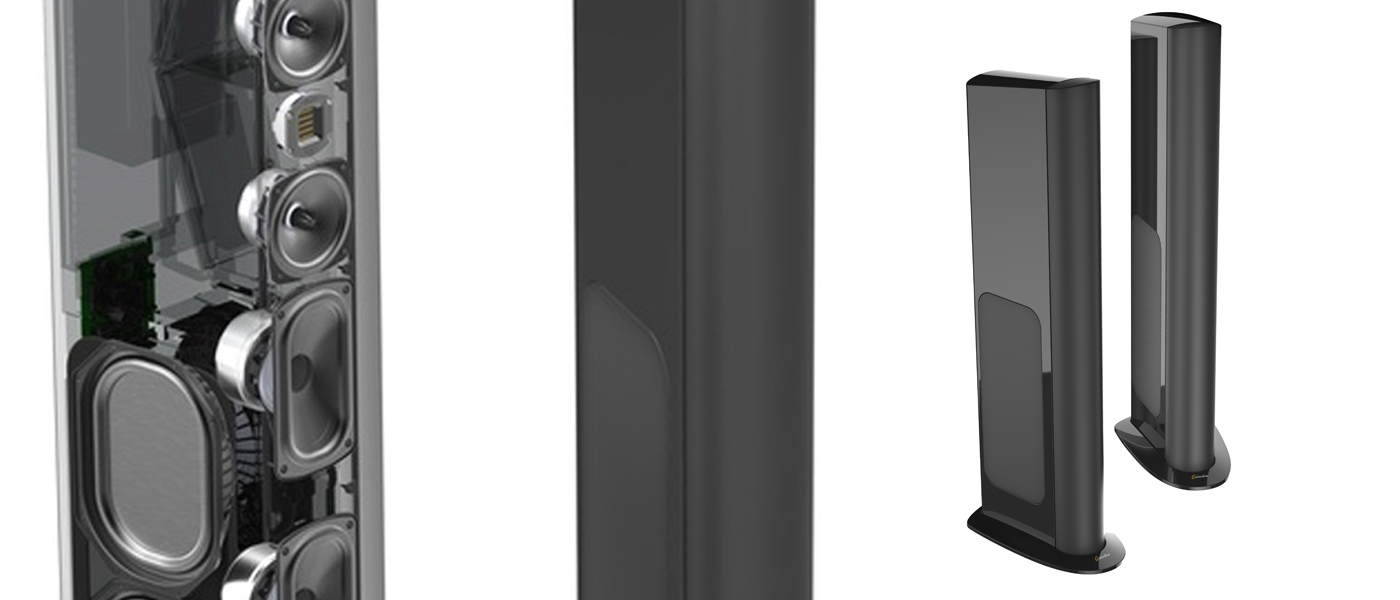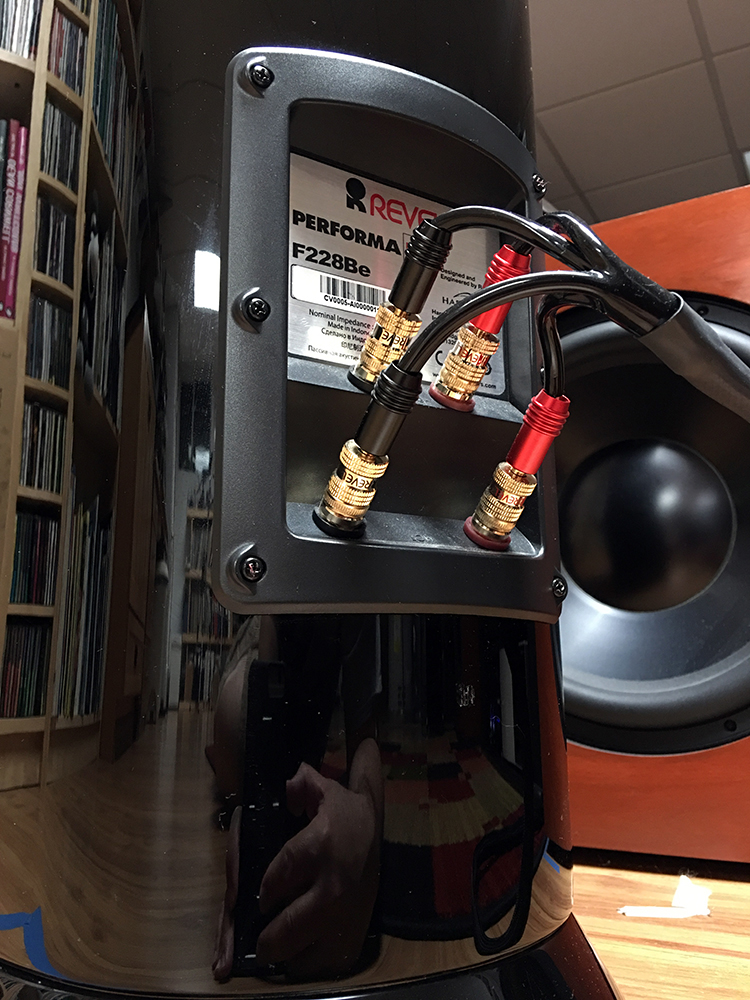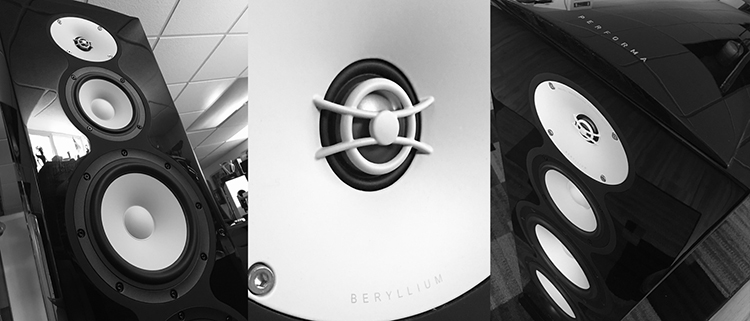
They design and create their product through the application of rigorous acoustic research, sound engineering practices, and controlled double-blind listening tests. The Revel Performa F228Be floor-standing loudspeaker is one of their latest offerings that aim to tempt the ears of discerning audiophiles.
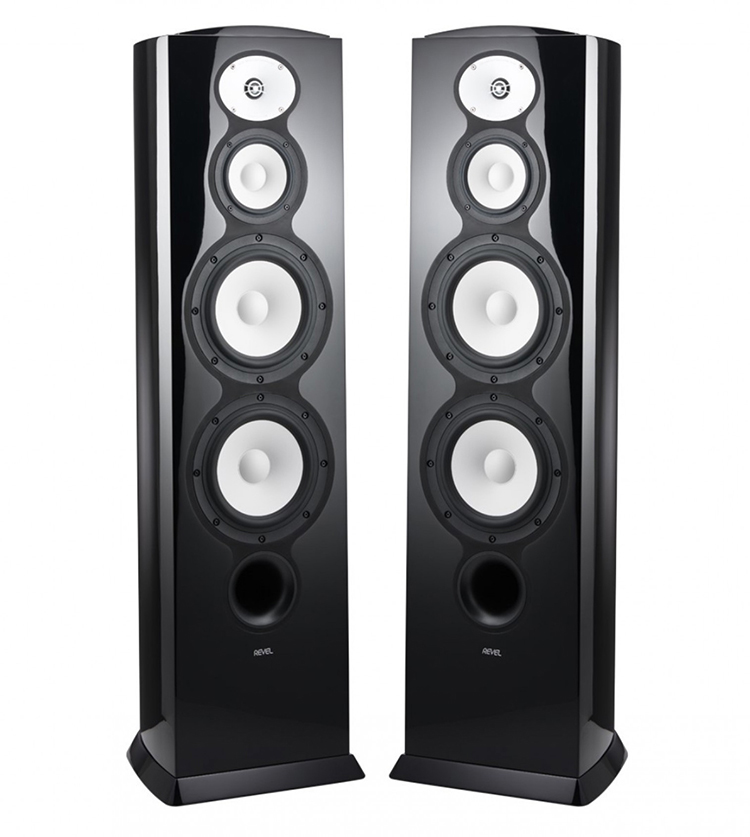
Revel F228Be Loudspeaker
- One of the most natural sounding speakers that I have heard.
- Every component has been redesigned and re-engineered for peak performance.
- They sound very good when listening off-axis.
- Beryllium tweeter with custom waveguide.
- Bi-wire and bi-amp capable.
- Solid impactful bass response. No need for a subwoofer here.
It’s no hidden secret that Revel produces great loudspeakers. The reality is that they produce outstanding loudspeakers, truth be told, and on a consistent basis too. Revel has a deep well of talent and experience in the acoustic disciplines combined with the vast resources of the Harman brand at its disposal. Therefore, there is precious little that Revel can’t do when they decide to sharpen their pencils and train their ears to the task at hand. The F228Be is the latest addition to the company’s Performa loudspeaker line and, at $10,000.00 a pair, it is twice the price of the F208 slotting between them and the Ultima 2 series of speakers. I’ve heard speculation that the F228Be feature technologies and improvements that will eventually make their way to an updated future Ultima line. At this point, it’s little more than the idle chatter of audio forum jockeys as Revel has plainly said in the past, it will update the Ultima line when it is good and ready to do so. Putting aside whether the F228Be is a harbinger of things to come, there is a more pressing question that it needs to answer for its own sake. Does it indeed “deliver the goods” relative to its price and position in the lineup? That’s what we’re aiming to find out.

Description:
3-way Bass Reflex Floor Standing Loudspeaker with front firing port
High-Frequency Driver:
Single 1″ Beryllium dome tweeter with custom waveguide
Mid-Frequency Driver:
Single 5.25″ Deep Ceramic Composite (DCC) aluminum cone mid-range driver
Low-Frequency Driver:
Dual 8″ (DCC) aluminum cone bass drivers
Frequency Response (-6dB):
27 Hz – 44 kHz (Manufacturer)
Crossover Frequencies:
260 Hz, 2.1 kHz
Nominal Impedance:
8 Ohms
Sensitivity:
90 dB (2.83 Volts @ 1 Meter)
Recommended Amplifier Power:
50 – 350 Watts
Available Finishes:
High Gloss Black, White, Walnut, Metallic Silver
Dimensions (H x W x D):
46.6″ x 13.5″ x 14.8″ (1182.5mm x 341.8mm x 375.3mm)
Net weight:
82 lbs. / 37.2kg
MSRP:
$10,000.00 (pair)
Company:
SECRETS Tags:
revel, tower, speakers, floor standing, beryllium, Floor Standing Review 2019
Secrets Sponsor
When looking over the specs of the Revel F228Be loudspeakers, I initially made the assumption that they were merely an evolutionary update to Revel Performa3 F208 speakers. It was a natural consideration as both towers share the same cabinet shape, driver complement, and layout when given a cursory comparison. In my subsequent discussions with Kevin Voecks, Acoustic Technologies Manager at HARMAN Luxury Audio, it became clear that beyond “wearing the same designer suit”, the F208 and F228Be are very different speakers altogether.
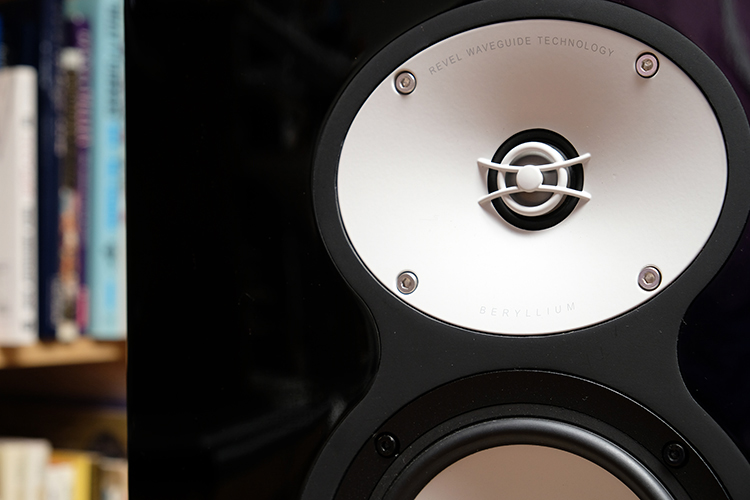
The “Be” in the model name should give you the first clue, a one-inch beryllium dome tweeter with an enhanced motor structure is used in the F228Be. Beryllium being chosen here for its high stiffness to lower weight, when compared to other metals. This is mated to a newly designed waveguide which helps improve the dispersion and maximize off-axis response. It’s also claimed that the waveguide helps the tweeter’s directivity match that of the midrange driver.
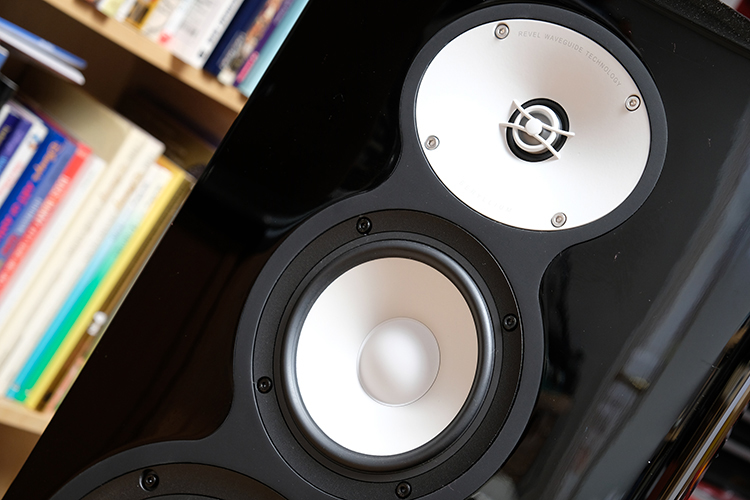
Both the 5.25-inch midrange and dual 8-inch bass drivers still have aluminum diaphragms, but they are coated, both front and back, with a coarse ceramic layer. Revel terms this new material sandwich, “Deep Ceramic Composite” or DCC. DCC helps to dampen any cone ringing and pushes any potential breakup modes to outside of the driver’s intended operating range. These particular drivers also get revised and beefed-up motor structures so that the whole package works to provide lower distortion with better power handling and efficiency.
The crossover design of the F228Be has also been reworked using high-order slopes while the treble and bass trim controls of the F208 have been removed, being deemed as unnecessary in the F228Be. In terms of accessories, the speakers come with lightweight grills that attach magnetically to the baffles, two sets of robust carpet spikes and a pair of foam cylinders for plugging the ports.
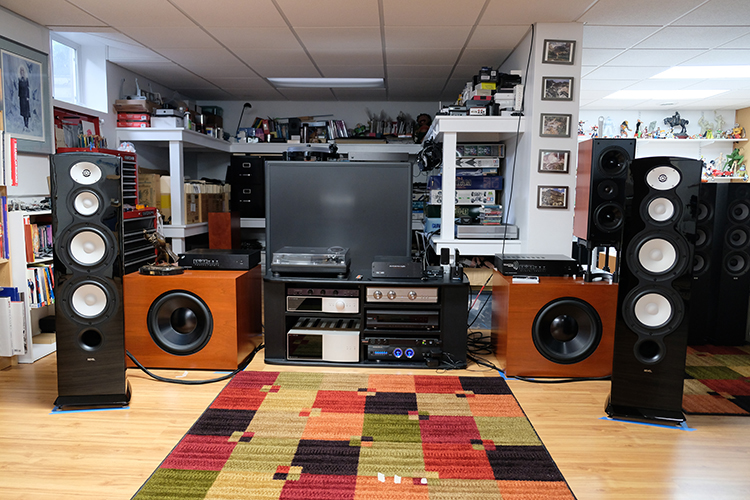
When the Revel F228Be speakers arrived, I set them up in my studio listening area where I engage in the majority of my 2-channel enjoyment. I had the towers positioned about 9-feet apart and toed-in at about a 10-degree angle, as this is how I customarily start off. My seating position was also just under 9-feet away from either speaker. After some tweaking, the speakers ended up being positioned with the sightline from the tweeters converging at a point just behind my head. An OPPO BDP-105D Universal Player served as the main source (using both discs and a hard drive full of FLAC and DSD files) while the Anthem STR preamp and STR power amplifier completed the audio chain. Occasionally, I would swap the STR amp for my SDS-470C power amplifier from Class D Audio. For a vinyl source, I used my Technics SL1200 Mk 6 modified by KAB Electroacoustic, along with an Audio Technica OC9ML/II Moving Coil phono cartridge. Speaker and interconnect cables were from Blue Jeans Cables.
To put it bluntly, this is one of those speakers that just sneaks up on you and before you know it, you’re hooked on them. That’s the best way I can describe the Revel F228Be. Aesthetically speaking, they are understated and handsome looking with their curved cabinets. My review samples were dressed in the High-Gloss Black finish with contrasting white drivers and the top black trim was speckled with metallic flecks. They are nowhere near as attention-getting as the Starke Sound speakers that I previously reviewed, but you would not find the Revels to be an unwelcome addition to any room you just happened into. Tastefully stealthy they are to the eye.
The typical measures we use to judge build quality all indicate the Revels to be a well-built product. The cabinets felt properly inert and rigid when subjected to my frequent knuckle-rapping. At 82 pounds apiece, the F228Be is suitably heavy but not ridiculous. Paint and polish finishing was done to a very high standard. The speaker’s 5-way binding posts are substantial and of excellent quality allowing for bi-wiring and bi-amplifying.
When considering the sound I experienced from these speakers in my room, they struck me as instantly agreeable from the get-go and my appreciation for them just continued to grow the longer I listened. I’ve heard speakers here that would hunt for my attention more than the Revels did. Some speakers are voiced to have more sizzle in the top end or have a more forward midrange so that the vocals in a performance pop when listened to. Other loudspeakers have demanded that I sit right in the sweet spot in order to get the best performance out of them. And bear in mind that beyond the electrical/mechanical design of a loudspeaker, it has everything to do with how a given speaker is positioned in, and couples with, my listening environment that is the ultimate determinative factor. Bass response, in particular, can be especially tricky to nail down in my listening room. Some speaker designs just work really well in this room while others are a bear to dial in. Consequently, if there were any audio component that could elicit the behavioral qualities of a diva, it would be the loudspeaker. The Revels, in real-world use, gave me no such mercurial mood swings, no tempestuous tantrums and didn’t play music like they were an attention junkie, flailing their arms, screaming “Look at me. Look at me”!
The Revel F228Be had an overall level of “rightness” to their sound and a natural degree of tone and extension that didn’t call outright attention to itself. That is, not until I swapped them out temporarily for other speakers I had around and inevitably felt that something was missing or wasn’t quite right. The Revels sounded natural, lacking in any excessive coloration that I could hear but with a clarity and an ability to retrieve all manner of musical detail without sounding ruthless or clinical. Smooth, even-handed, nicely judged were all expressions that were scribbled in my notebook throughout many listening sessions with these speakers. The F228Be sounded very good when being listened to, casually, far off axis as well. I didn’t feel as if I was giving up entirely too much sound quality when I wasn’t planted firmly in the money chair. Bass response was exceptionally good, reaching deep enough to erase the need to experiment with adding a subwoofer, notwithstanding the sadistic joy of doing so anyhow! The bass of the Revels did excite a few room modes below 300 Hz that, while not sounding awful, did muddy up the low end a little bit. I ended up using the Anthem STR preamp’s ARC room correction set with an upper EQ limit of 500 Hz to smooth and sort out the deficiencies of my room. With the room modes addressed, bass remained deep but now had a bit more clarity and detail to whatever notes played at those depths.
Most speakers that I’ve had come through here that I really like (including some really expensive ones), inevitably have some sort of compromise somewhere. Something in the response, the size, the weight, the look, the price. Speaker design is nothing if not the balancing of a whole slew of compromises in order to create something that’ll move you with its sound. And while I’ve not had the pleasure of listening to every speaker made in recent years, these Revels are the kind of loudspeakers that make me seriously wonder if I ever need to. And I admit that sounds rather sacrilegious when I read that back to myself. They may not have the sheer lung capacity of the JBL 4367 or the top end airiness and nth degree build of the Paradigm Persona 7F but I’ll be damned if I can come up with another such linear transducer, that makes me feel like I am hearing so much, yet giving up so little.
The following are a few notable musical selections that I felt showed off the Revels during our time together:
Quinlan Road CD.
I saw Loreena Mc Kennitt live in concert at the old Ontario Place Forum many moons ago, and this CD brings back a slew of memories of that wonderful show. Ms. Mc Kennitt’s voice has such a distinctive and haunting quality to it which the Revel F228Be rendered beautifully throughout each track of this two-disc set.
The song “The Mystic’s Dream” begins with wonderful Celtic-based rhythms, comprised of bagpipes, various percussion, fiddle, the oud, and a hurdy-gurdy. The Revels painted an expansive canvas, capturing fully both the depth and width of the instruments spread across the stage and the acoustics of the performing venue. The tone and detail of the bagpipes were relayed perfectly to my ears. Rich and clear sounding without any abrasiveness. The unique sound of the oud, a middle eastern ancestor to the lute and guitar, came through clearly through the Revels, sporting lovely tone and plenty of string detail. The bass from the drums and other percussive elements was deep and solid providing an excellent foundation for the performance. And then we come to the voice. Ms. Mc Kennitt’s refined and powerful soprano is a force I have heard on many different loudspeakers of various price and quality and it is not kind to those whose designs don’t measure up. The Revels handled it supremely well with excellent tone and not a wisp of breakup or harshness, even at high volume. The same observations extend to “Bonny Portmore” and “Between the Shadows” which also feature Ms. Mc Kennitt’s prodigious talent at the harp. The Revel F228Be excelled at pulling all the detail out of both ends of the stringed spectrum here, both from her brisk yet delicate harp plucks to the punchy, deep cello plucking from her bassist. Very satisfying.
MCA CD
Turning to something a bit rawer and less refined, “I’m Bad Like Jesse James” gets personal. Downright savage actually. John Lee Hooker lays out in verse how he plans to “do in” a so-called friend for bragging about seducing his wife.
The intensity builds up slowly with the Revels giving terrific punch and depth to the incessant bass line, sounding almost like it’s the tick-tock of some maniacal clock. A piercing single guitar note tolls over and over like some grim reaper’s chime, the Revels conveying the mood so successfully. The drum skins are closely mic’d and I’m able to hear all the skin details while Hooker’s voice is in your face with all its deep, resonant viciousness coming through. This song is dripping with character and malicious intent and the Revels succeed in making it feel, uncomfortably, real. On the much slower and sadder “Heartaches and Misery” the Revel F228Be allowed me to easily pick out the individual guitar parts of Hooker, Muddy Waters, Sammy Lawhorn and Luther Johnson, each one distinct in its tone but often at such low levels that they could be otherwise be missed. Otis Spann’s piano work had a great ring and decay to the notes as well.
SACD
A wonderfully recorded version of Mahler’s 6th Symphony. Spacious, clear, and detailed nicely sum up how this entire work sounded through the Revel F228Be. The dynamics too were there in spades.
The Revels clearly and cleanly uncovered all the smallest musical details in the quietest passages and yet were immediately able to cope when the volume and intensity switched on a dime, all without the slightest strain. Massed strings had just the right amount of shimmer to them and spanned well out beyond the speaker boundaries. The horns sounded crisp and brassy yet didn’t irritate after prolonged listening. The infamous hammer blows during the 4th movement, while not subterranean, sounded powerful and felt palpable when rendered by the Revels.
Guardian Records CD
Most people my age remember The Power Station for their 1985 hits “Some Like it Hot” and “Get it On (Bang a Gong)”. I wonder how many people also remember that the group actually reunited and released this second album in 1996.
Probably not many, which is a shame because it is a solid follow up album where the band (minus original bassist John Taylor) got to stretch themselves a little more. Starting with the opening track “Notoriety”, the Revels make you feel Tony Thompson’s kick drum square in the gut while riding along with Bernard Edward’s rumbling bass line. Andy Taylor’s guitars still had that slick distorted playing style that was a hallmark of his years in Duran Duran, just turned up a few more notches here. The late Robert Palmer had one of the most underrated voices in rock and pop music and the F228Be allowed me to remember just how good he really was. A smooth and powerful vocal delivery that the speakers gave just the right amount of body and texture. More of the same continued when listening to “Power Trippin” but with the addition of a tight and rhythmic horn section. Horns sounded nicely crisp and brassy without getting too thin or irritating. “Living in Fear” is a guitar soaked hard rock number where Palmer pulls out all the vocal stops and Taylor has multiple layered electric guitar parts. The Revels make this sound particularly good when the volume is cranked up. It was quite clear that the F228Be will do hard rock. They will do it loud and laugh it off while asking for more.
Technical analysis by: David A. Rich
Carlo is limited in his ability to do quasi-anechoic measurements with such a large speaker that cannot be put on a high stand. I will show some data with the reflections windowed out, which will limit the resolution and introduce some oscillations in the curve that are an artifact of the window.
Harman has supplied us the true anechoic data for the F228Be, the ANSI/CEA-2034 curve set, which is shown below. For a detailed explanation of the ANSI/CEA-2034 standard please see my Revel M106 review.
The 5 graphs are best understood with a textbook written by Dr. Toole:
Floyd Toole, “Sound Reproduction: The Acoustics and Psychoacoustics of Loudspeakers and Rooms.” 3rd edition (Taylor and Francis, 2018)
Chapters 5, of the text, covers the measurements and interpretation of the curve set. A free annotated power point presentation by Dr. Toole covering some of the material is on the Harman website. The 3rd edition of the text has been significantly re-organized. The material is in chapters 17 and 18 of the 1st and 2nd editions but I highly recommend you get the 3rd edition.

The listening window shows a flat response with a slight rise at the transition to the tweeter. What happened to the tweeter level control? The early reflection response which reflects the summation of the reflections that can occur in most rooms on the floor, wall, and ceiling is the red curve. The researchers who developed the early reflection curve examined 15 different rooms of varying square area and aspect ratios to account for most of the possible first reflections.
This paragraph is a Readers Digest description of how to read the curve. The key attribute of this curve is that it should be monotonically decreasing. The other key attribute of the curve is the ratio of the listening window to the early reflection response, which should be monotonically increasing. This ratio is the Directive Index (DI) of the early reflection curve (orange curve). If the speakers DI were not monotonic it would introduce an undesired, room dependent, sonic signature.
Secrets Sponsor
Numerous blind tests with trained listeners have shown that the best scoring speakers have the properties described in this paragraph. A Directivity Index for the power response (purple curve) is also presented. Ideally, it will have the same properties to the early reflection curve and directivity index. The difference is this curve shows reflections which start at any point of the speaker’s response and the reflection may experience several bounces before reaching the ear.
This is where this speaker is most impressive. Almost no lumps or bumps are observed in the early reflection curve or in its directivity index. The same impressions apply to the sound power (blue) and its directivity index (purple).
To appreciate how closely the speaker is getting to the design goals for the ANSI/CEA-2034 curve set by the F228Be, I have the ANSI/CEA-2034 curve for the Revel F208. The F208 produced results that were considered close to the limits for a passive speaker design using cone and dome drivers when it was introduced.
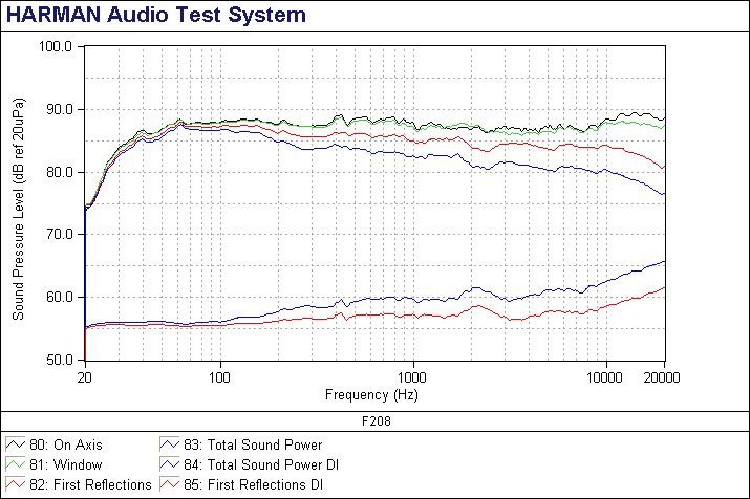
When compared, note that the drop in energy at the midrange-tweeter crossover in the early reflection and sound power of the F208. We also see the corresponding bump in the early reflection and sound power directivity index that is absent in the F228Be.
The additional bump in the early reflecting and sound power curves at 6kHz is also gone in the F228Be curve set although some excess energy can be seen in the listening window that is not as significant in the F208. The 6kHz energy bump in the F208 is lower than the rest of the family (M105, M106, and F206) indicative of a selected tweeter for the F208. You can see the bump in the data in my M106 review.
In the F228Be the new waveguide and tweeter have removed the 6kHz bump off the graph.
While the F228Be is clearly improved, the F208 at half the price still produces an excellent ANSI/CEA-2034 curve set. In my opinion, if the F228Be is out of your budget the Revel F208 remains a speaker you must hear if you have $5000 to spend.
I (David Rich) still consider it the best speaker I have auditioned in my house.
The early reflections curve is a summation of over 30 individual measurements at different angles from the front of the speaker in the horizontal and vertical plans. It is very useful to look at the individual curves to gain more information about the speaker performance. Carlo thus undertook to generate these individual curves. Doing these in Carlo’s listening room results in reflections that have to be windowed out if the data is to have some accuracy. This limits the frequency response of the curves. Luckily most of the performance difference in the F228 is above 1kHz. The REW acoustics measurement program was used with a Cross Spectrum Labs calibrated UMIK-1 miniDSP USB microphone.
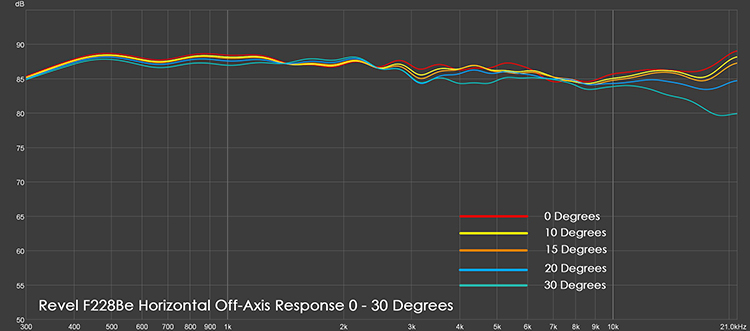
Above is the horizontal radiation curve of the F228 to 30 degrees. The response dip below 500Hz is a measurement artifact of the small window width to remove the room reflections. Other smaller oscillatory patterns are also from the windowing. The 5-inch woofer shows very little directionality out to the 2kHz crossover. After the crossover to the tweeter, we see some small reduction in amplitude as the angle increases from the waveguide. It converges at 7kHz and then the directivity of the dome becomes more apparent.
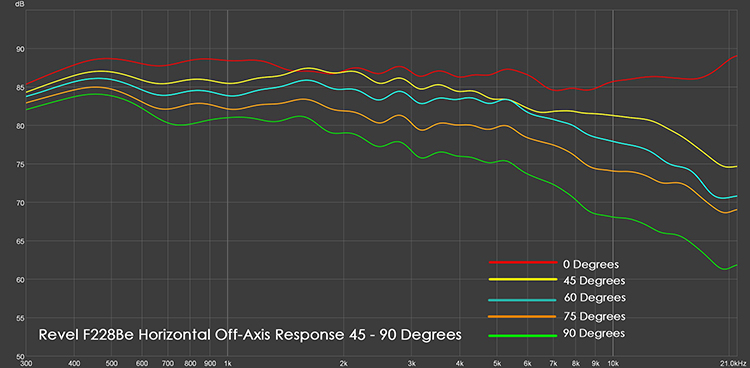
Moving out to wider angles the performance of the crossover and waveguide becomes more apparent. Again, ignore the oscillatory pattern in the curve. The key observation is how these curves remain monotonically decreasing. The directivity pattern of the midrange is almost exactly matched to the tweeter and its waveguide except for 45 degrees which shows a small upward drift near the crossover. This is as close to the ideal performance as we are likely to see in a speaker with passive crossovers, at least in a 3-way design.
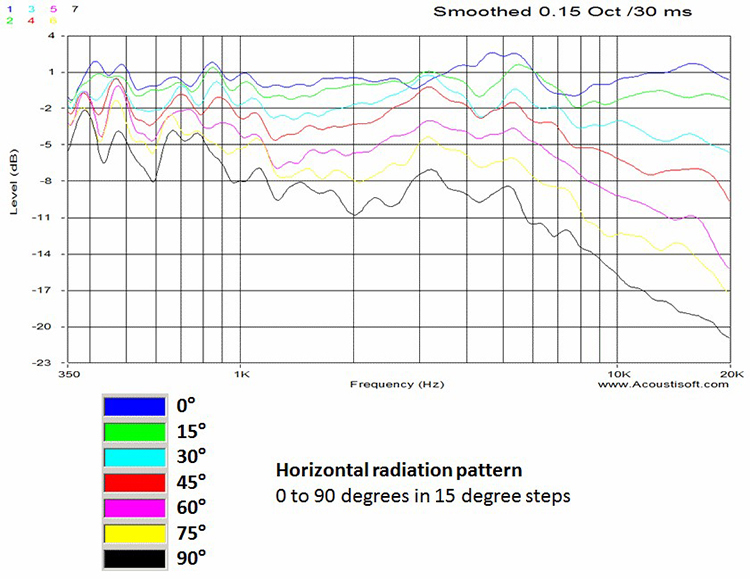
Above is the vertical radiation pattern for the Revel M106 that I produced for my review of the product.
The 6.5-inch woofer shows significantly more energy loss at higher frequencies. The response inverts around the crossover before it begins to decline again. Note the 6kHz resonance absent in the F228BE. Also, note the significant more energy loss at higher frequencies for the M106. This is indicative of the advances in waveguide design in the F228BE. Recall we are comparing speakers with a five to one price difference.

The figure above is the vertical radiation pattern for negative angles. The notches that occur at higher angles are a result of the physical separation of the two drivers. The separation introduces a delay which causes destructive interference when both drivers are active. No constructive interference is seen in the vertical radiation pattern. This is consistent with a speaker having acoustic slopes matching a Linkwitz–Riley crossover. Note that no resonance is seen in the tweeter.
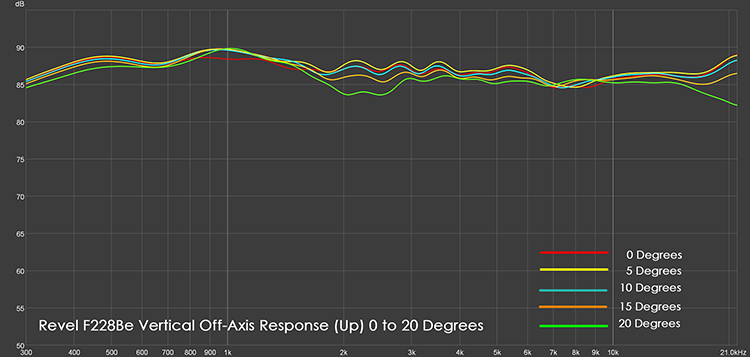
Moving to the vertical radiation pattern for increasing angles, we see significant improvement from the M106 (not shown, please see the original review). The depression occurs at a smaller frequency range and is not as deep. Much of the absence of a dip in the ANSI/CEA-2034 of the F228BE in comparison to the F208 can be explained by the improvement in this curve set.
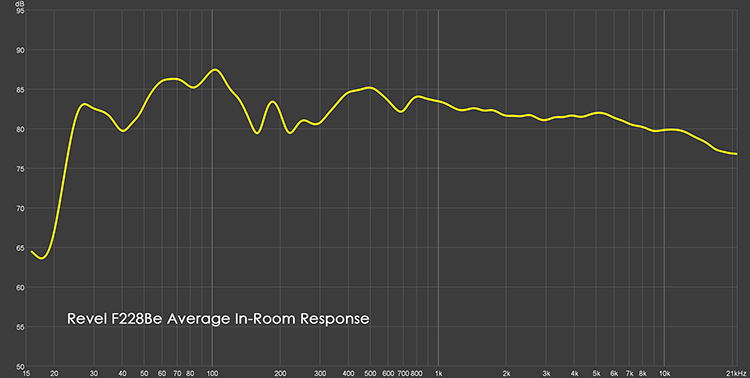
The in-room measurement is an 18-point spatial average. A 9-point measurement was made for the right speaker and then repeated for the left speaker. Averaging both speakers is an approach others have been using and publishing. Using data from both speakers reduces the modal response of the room by averaging the differences in the response of the two speakers from room asymmetries. The technique cannot eliminate them and the response below 300Hz remains room dominated. The 700Hz dip is not understood but is an issue with the measurement. The depression between 150Hz and 400Hz are an issue with early reflection. We are working to reduce these room reflections and perhaps change the microphone positions to more accurately reflect the performance of the speaker. The press of time for publication has only allowed us to show the preliminary results.
Ignoring the 700Hz dip from 500Hz to 18kHz, the desired target curve for this speaker has been achieved. The Harman target curve development was disclosed in the paper below:
S Olive, T Welti, E McMullin Listener preferences for in-room loudspeaker and headphone target responses – Audio Engineering Society Convention 135, 2013 – aes.org
This slowly declining in-room response has been determined to be the one preferred by trained listeners in blind tests.
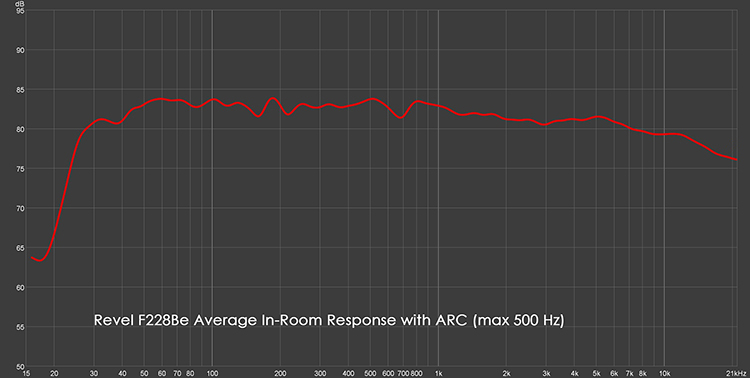
This in-room response graph is shown for the sake of clarity and curiosity. Using the Anthem Room Correction system afforded by the Anthem STR preamplifier, we were able to smooth out the bass response of the speaker in the listening room. This helped remove some excess reverberation at the lower frequencies while keeping a good sense of room gain in the low-end response. ARC was strictly limited to 500 Hz maximum equalization. Everything above that is the speaker’s own doing. Much of the subjective listening impressions were made with this EQ correction actively in use.
You could want more than the REVEL F228BE. The honest question is, do you really need more?
- Natural, uncolored sound quality, top to bottom.
- Excellent off-axis response.
- Powerful, solid bass performance.
- Understated good looks.
- A pair of them on my birthday, gift-wrapped with a bow. I turn fifty this year you know!
The Revel F228Be are a very dangerous pair of speakers. They are stealthy, unassuming and impeccably well engineered. They are the kind of product that makes you ask yourself if you really need anything more when it comes to loudspeakers. Now, a price tag of $10,000.00 for the pair, is not chump change by anyone’s standards, but I’ve heard speakers that cost twice that much and more, that don’t bring me the level of enjoyment while being as easy to live with as these speakers are.
The level of clarity and detail retrieval they provide is about as best as I have heard from a passive loudspeaker. Vocal reproduction is equally flawless and about as uncolored as I have come across. Bass response was deep, potent and detailed, especially when tempered with just the right amount of room correction in my case. Soundstage reproduction and off-axis response are equally impressive, so you don’t have to be in the sweet spot all of the time. Practically speaking, they have no real weaknesses that I can divine. That makes them a benchmark in my book when it comes to stereo speakers. I don’t know what Keven Voecks and the folks at Revel have in mind to top the F228Be when the sights turn to update the Ultima2 line. But until that fateful day, and if financial fortune should ever smile upon me, I’ll take my pair of F228Be in Walnut, please! (David Rich adds, he would like his in Walnut as well but black is OK. He currently has no other speaker on his wish list.)


